Compared: 16-inch MacBook Pro vs Razer Blade 15 Advanced
Apple used the Razer Blade 15 Advanced as a point of comparison for the performance of the M1 Max chip. Here's how the rest of the notebook compares against the 16-inch MacBook Pro.
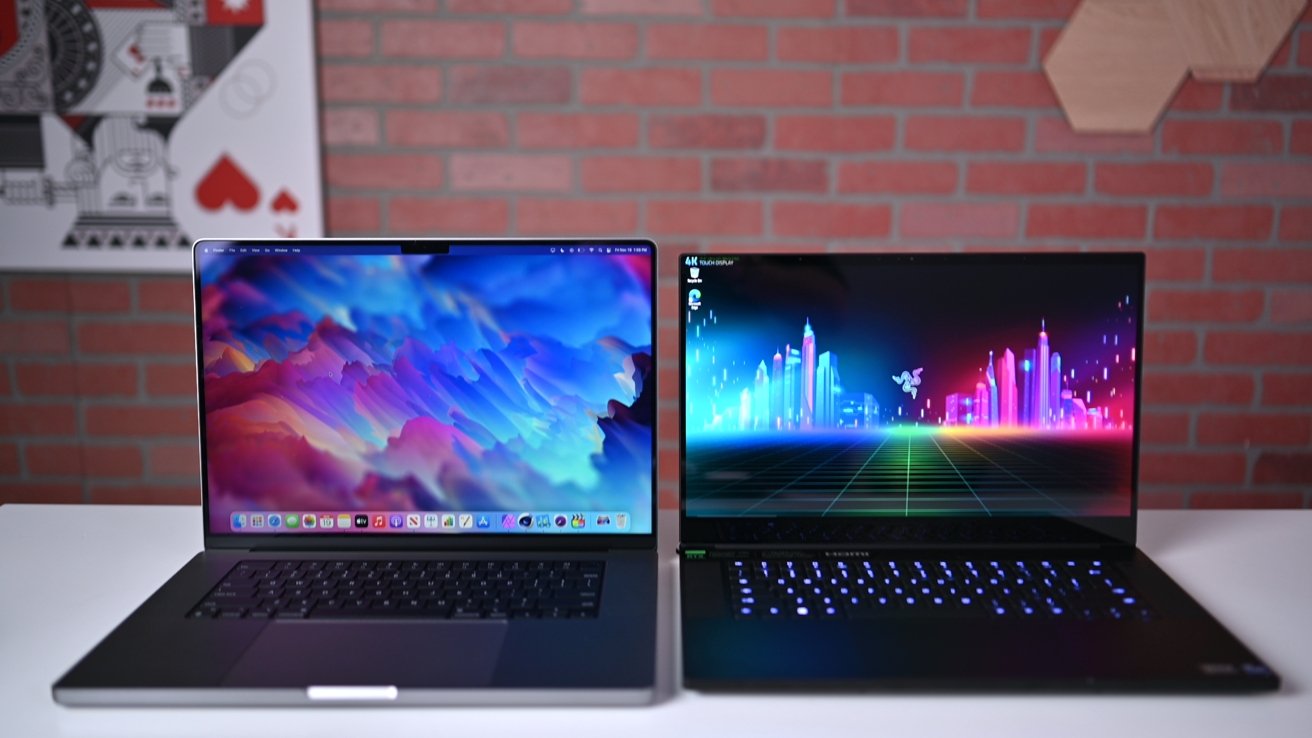
16-inch MacBook Pro vs Razer Blade 15 Advanced
As part of Apple's promotion of its new M1-series MacBook Pro system-on-chip options, it made claims comparing the performance of the SoCs against existing on-the-market notebooks.
One comparison of the M1 Max with the 32-core GPU option claimed it offered "graphics performance comparable to that in a high-end compact PC pro laptop using up to 40% less power." A closer inspection of the press release has Apple saying that compact notebook was the Razer Blade 15 Advanced, complete with the model number, RZ09-0409CE53-R3U1.
At first glance, the configurations list of that particular notebook points to Apple selecting a very high-performance system, one that would be the epitome of a gaming notebook.
Using Apple's selected Razer Blade 15 Advanced configuration, here's how the rest of the notebook compares to the 16-inch MacBook Pro.
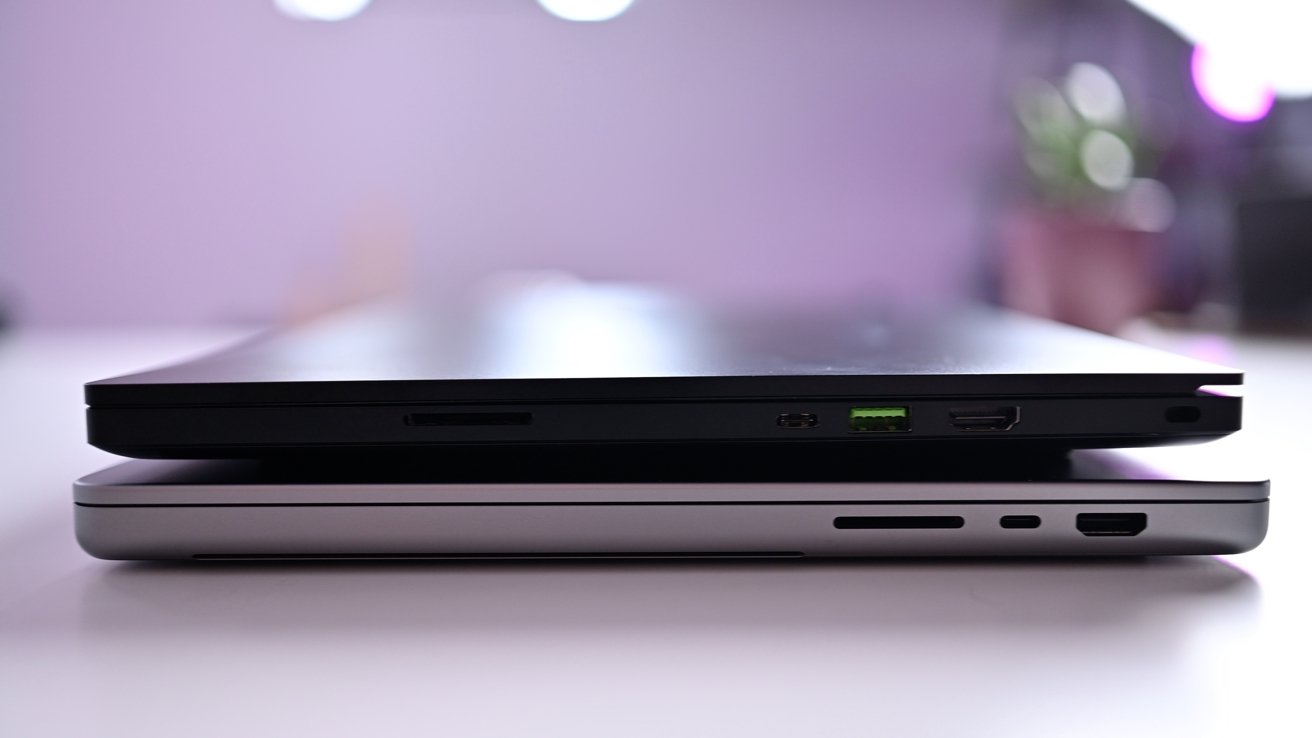
Razer has tried to follow the same path with its own products, following Apple's playbook in providing a signature style and color scheme that it certainly employs in the Blade 15 Advanced. Razer certainly goes for a similar industrial appearance with flat sides and a thin body, though it uses a slight taper on the sides to enhance its slim appearance.
The body does copy Apple in being aluminum, except here Razer has anodized it black and made the company logo on the top a bright and contrasting green.
Apple has the larger design overall, but not by much, with a 14.01 by 9.77-inch footprint countered by Razer with 13.98 by 9.25 inches. The difference in footprint can be accounted for by Apple having a slightly larger display, but they're still quite comparable.
As for the thickness, the 16-inch MacBook Pro is 0.66 inches, while the Razer is 0.67 inches. This is quite commendable for Razer, given that most gaming notebooks tend to be much thicker overall.
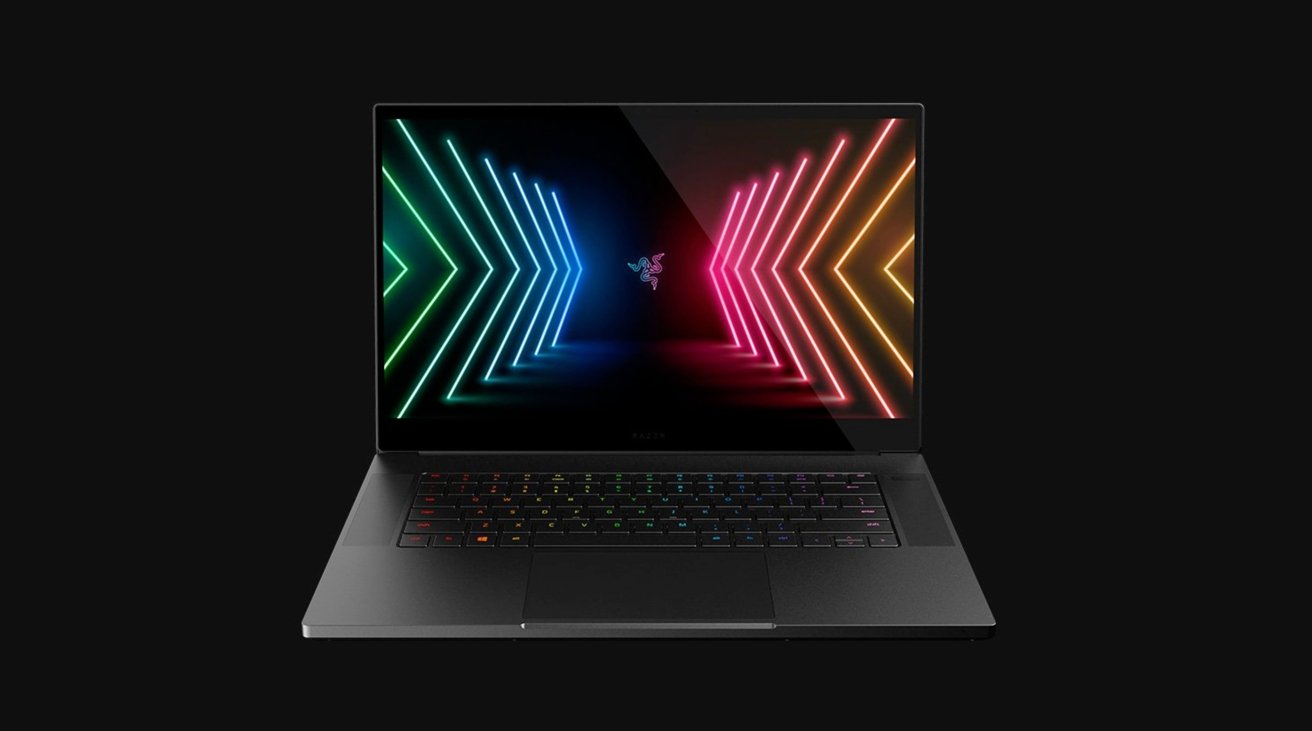
Razer includes a smaller display, but one with a higher pixel density than the 16-inch MacBook Pro
On the weight side, Apple loses out a little bit here, in that the 16-inch MacBook Pro is either 4.7 pounds or 4.8 pounds, depending on whether you go for the M1 Pro or M1 Max. Meanwhile, the Blade is a bit lighter at 4.4 pounds.
Apple's display has a resolution of 3,456 by 2,234 pixels, which gives it a pixel density of 254 pixels per inch. Razer's screen in this configuration is a 4K panel with a resolution of 3,840 by 2,160, and a higher pixel density at 282ppi.
There's a competing of technologies as well, with Apple choosing to use Mini LED for its backlighting, giving the MacBook Pro high levels of brightness at 1,000 nits fullscreen, 1,600 nits at peak. It also includes Wide Color (P3), True Tone, ProMotion support, and a 1,000,000:1 contrast ratio.
Razer's display in this particular notebook is an OLED panel, which can result in a brighter image with extremely high contrast ratios and color representation versus typical LED-backlit LCD screens. Razer has not specified what the contrast or brightness of the display are, but it's safe to expect the OLED panel to be bright and high quality in its own right.
The company does say the Blade's screen has 100% coverage of the DCI-P3 color space, HDR support, individual factory calibration, and a 1ms response time.
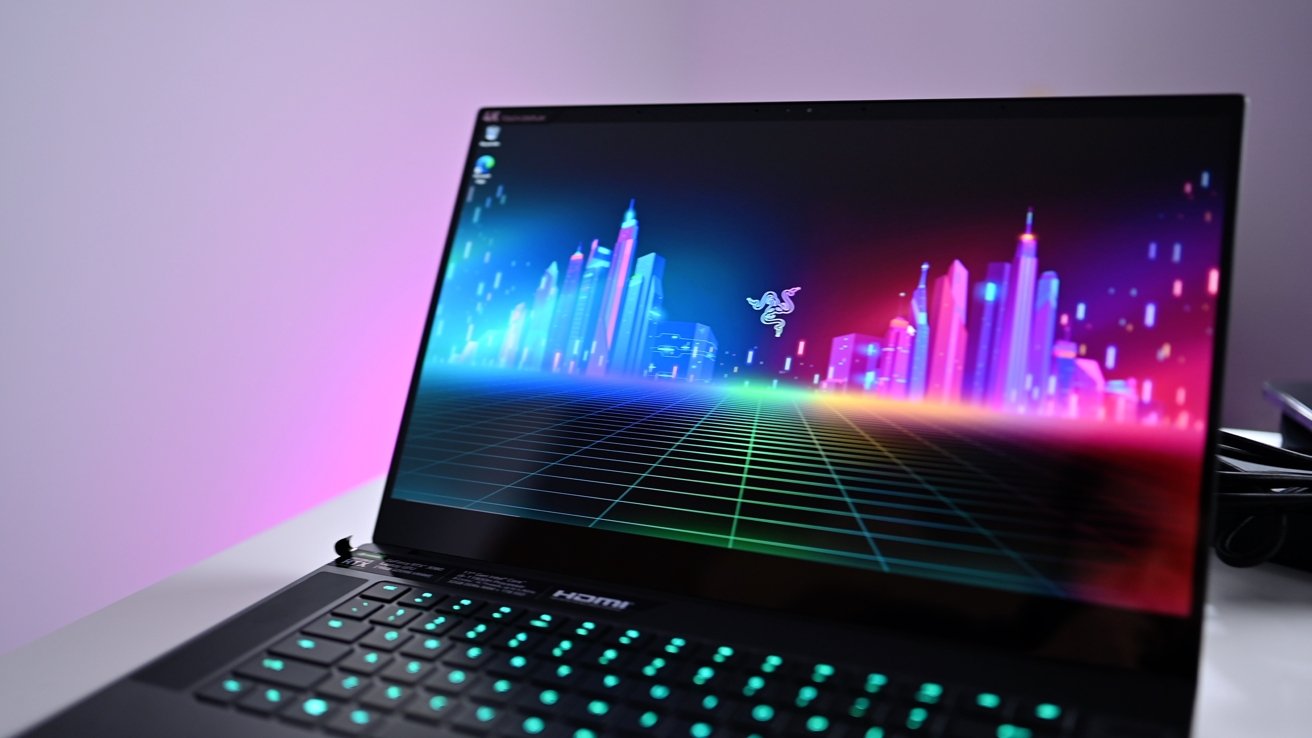
The OLED panel on the 4K Blade 15 Advanced is also a touchscreen.
The refresh rate for the Blade is just 60Hz, which is fairly standard, though while it falls short of Apple's display, it even fades behind alternate Blade configurations, such as a 360Hz 1080p screen, or a 240Hz QHD display.
The Blade does, however, benefit from being a touchscreen, an often clamored-for technology by some MacBook Pro users that has simply failed to make it onto the Mac.
Apple's screen is slightly hindered by the inclusion of a notch in the middle of the top edge, which cuts into the display. While it eats into the menu bar, macOS does push full-screen content to below the notch itself, effectively using the same space as a 16-inch display.
For example, the Fabric in M1 Pro has a memory bandwidth of up to 200GB/s, whereas the M1 Max has double at 400GB/s. You can also have more memory on the Max, as the M1 Pro starts at 16GB with a 32GB option, while the M1 Max starts at 32GB with a 64GB upgrade available.
Another difference is the Media Engine, a new addition that handles video encoding and decoding tasks in an efficient way. Both can deal with H.264, HEVC, ProRes, and ProRes RAW encoding and decoding, but the M1 Max has two video encode engines and two ProRes encode and decode engines over the M1 Pro's version.
The Blade configuration used by Apple has the Intel Core i9-11900H, an 11th-generation Tiger Lake chip from Q2 2021. The eight-core, 16-thread chip has a base clock speed of 2.5Ghz, rising to 4.9GHz under Turbo Boost.
On a benchmark basis, the Core i9 scores around 1,600 for Geekbench 5's single-core test, rising to around 9,100 for the multi-core score.
In AppleInsider's running of the benchmark, the M1 Pro scored 1,760 and 7,723 respectively in the single and multi-core tests, while the M1 Max managed a comparable 1,769 and 12,308.
Obviously, Apple's new chips are running better, in part due to the higher per-core score, and that there are 10 cores to Intel's 8 cores.
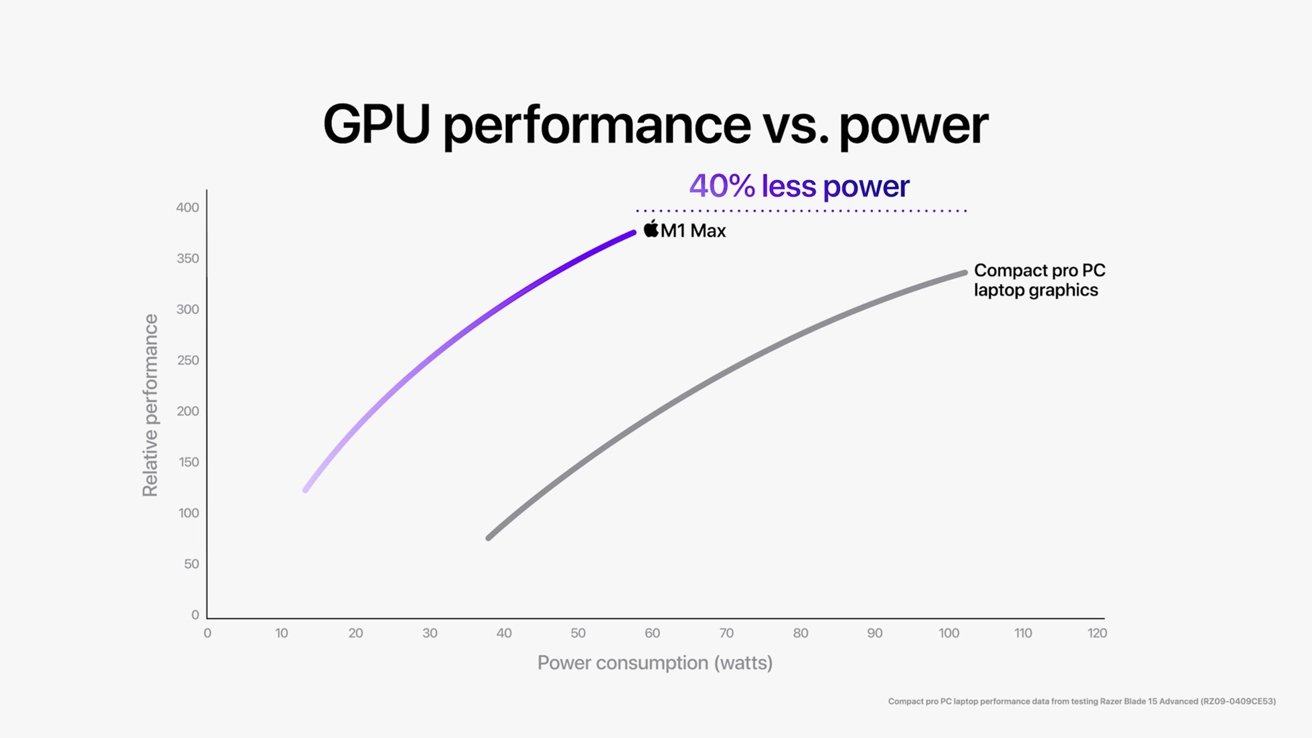
This Apple-produced chart compared the 32-core GPU in the M1 Max with the Razer Blade 15 Advanced.
For that specific configuration, the Blade 15 Advanced was packed with an Nvidia GeForce RTX 3080 with 16GB of GDDR6. Razer also has configurations for an RTX 3060 and RTX 3070, but Apple went for the top end of the spectrum.
The processor also offers Intel UHD graphics as an integrated alternative to the discrete GPU.
The M1 Pro for the 16-inch MacBook Pro has an Apple-designed GPU with 16 cores, while the M1 Max increases the count to 24 cores or 32 cores.
Since Apple uses Unified Memory, the GPU shares the same pool of memory as the CPU, similar to integrated graphics options. It differs in that the Unified Memory structure allows the CPU, the GPU, and other elements to access the same memory collection without duplicating data into separate pools, making it potentially more efficient for processing.
This means that the GPU's memory relies on the amount configured with the Mac itself, so it has up to 64GB to play with in the higher-end configurations. To a point, this pretty much negates the Blade's advantage of having so much dedicated video memory.
AppleInsider's Geekbench 5 Metal benchmark tests saw a score of 40,991 for the M1 Pro with a 16 core GPU, while the M1 Max with a 32-core GPU achieved 68,950 in the same test. For reference, the M1 with an 8-core GPU scored 21,425 under the same test.
Here's where things get muddy, as it is not currently possible to perform the same Metal test using an Nvidia GPU due to a long-term lack of macOS support. The nearest analog would be the GeekBench OpenCL test.
As of yet, there are no posted OpenCL test results for the M1 Max or M1 Pro, however, there is one for the M1, at 18,260. Geekbench says the Geforce RTX 3080 as a laptop GPU scores 128,800.
Even if we go by Apple's claim of the M1 Max being four times as powerful as the M1, this still puts the theoretical M1 Max GPU's score at around 80,000, which still leaves quite a gap.
It remains unknown what exact combination of benchmark results Apple used to score a higher "relative performance" than that specific Blade's GPU, but it certainly doesn't take away the fact that Apple's made an integrated GPU that can perform very well.
At the same time, doing so without being as power-hungry.
Razer uses its own 1080p webcam, though it is one with infrared capabilities, enabling it to support Windows Hello. This gives it a form of visual biometrics that Apple could've countered with Face ID, if it had included the aforementioned TrueDepth camera.
On the subject of biometrics, Apple does still offer Touch ID via a button in the top-right of the keyboard.
The configuration of the Blade Apple selected uses a 1TB M.2 PCIe NVMe drive. Technically, you can have two such drives installed, so you can add a secondary drive for extra storage, or even replace the original drive.
There simply is no option to upgrade the storage of the 16-inch MacBook Pro, unless you use an external Thunderbolt drive or something similar.
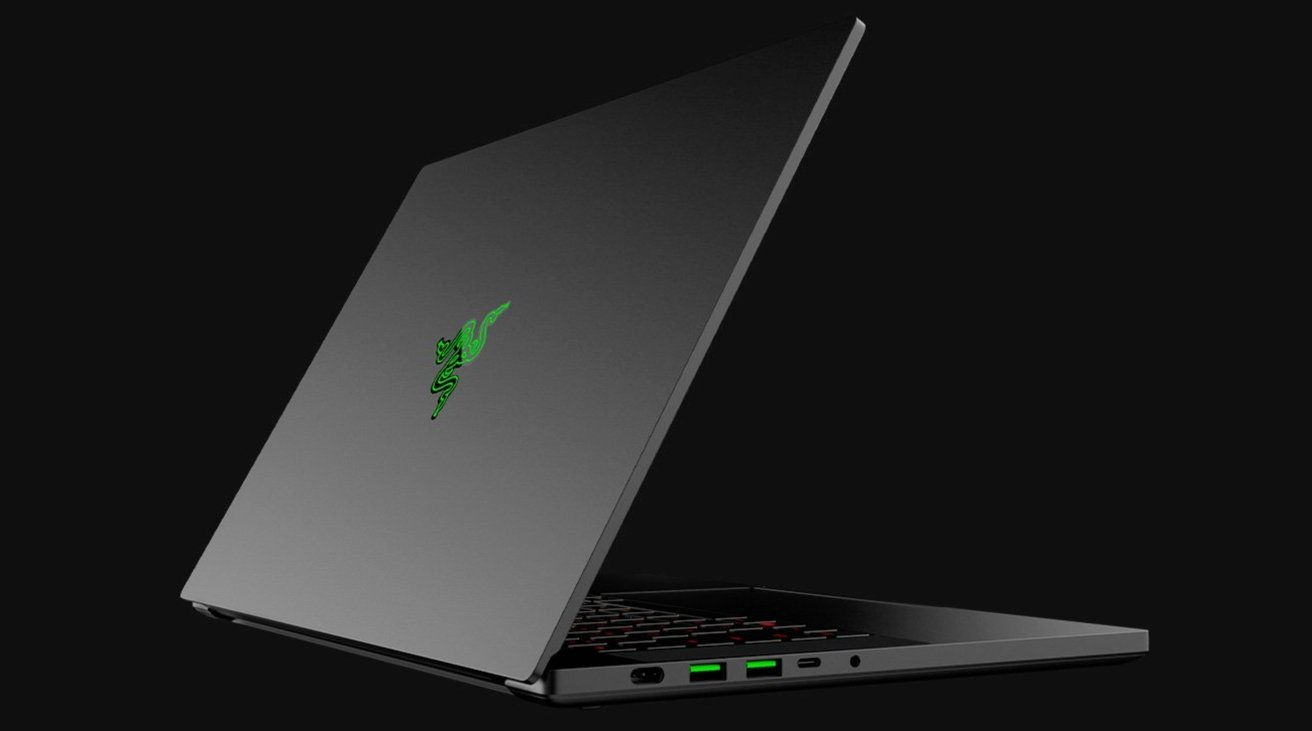
Razer uses anodized aluminum for its Blade 15 Advanced casing.
On memory, Apple offers 16GB or 32GB of Unified Memory in the M1 Pro, rising to 32GB or 64GB in the M1 Max.
The Razer Blade 15 Advanced uses 32GB of DDR4 3,200MHz dual-channel memory, but again these are components that could be switched out for higher capacities at a later time. Once more, you cannot perform such switching with the MacBook Pro.
For connectivity, the 2021 MacBook Pro models improve from the previous generation by offering three Thunderbolt 4 ports along with HDMI, an SDXC card slot, a MagSafe 3 power connection, and a headphone jack.
Razer includes two Thunderbolt 4 ports, two USB-C 3.2 Gen 2 ports with 15W power delivery, 3 USB-A 3.2 Gen 2 ports, an UHS-III SD card reader, a HDMI 2.1 port, a power connection, and a headphone jack.
For wireless connectivity, the MacBook uses Wi-Fi 6 and Bluetooth 5.0, while the Blade opts for the newer Wi-Fi 6E and Bluetooth 5.2.
Apple includes a bigger battery in its MacBook Pro at 100W, versus the Blade's 80W unit. It also seemingly lasts longer in the MacBook Pro, with Apple claiming it offers up to 21 hours of video playback or up to 14 hours of wireless web access.
By contrast, reviews and benchmarks for the Razer put its battery life at around 6 hours on average. This isn't exact, as there's variations in testing methodologies at play, but given the generally low battery life of gaming notebooks, the figure is reasonably close to reality.
Razer includes a more powerful power supply with its Blade at 230W, while Apple uses a 140W version.
Apple includes more speakers in its MacBook Pro, with six including force-cancelling woofers and Dolby Atmos support to the Blade's Stereo with THX Spatial Audio support. Razer, however, has one more microphone at four in an array versus Apple's three with directional beamforming.
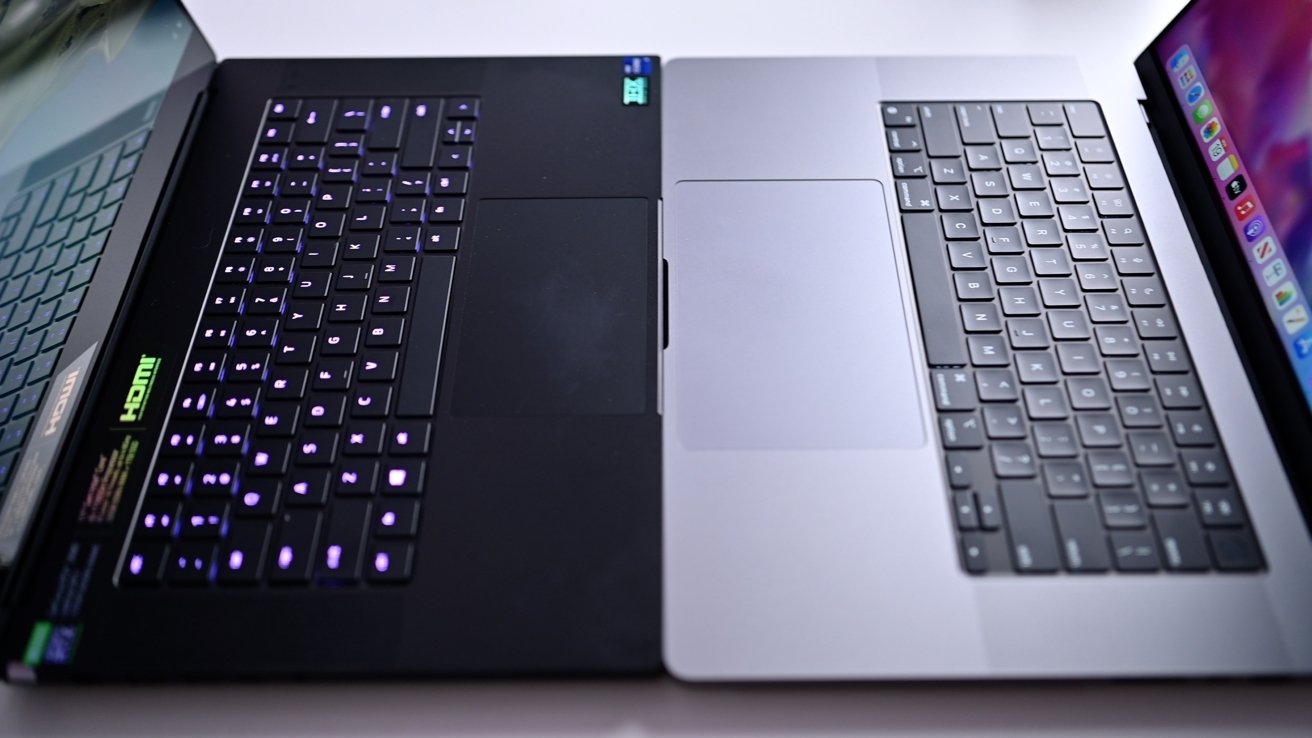
The keys are individually backlit on the Blade 15 Advanced, with full RGB capabilities.
The MacBook Pro keyboard includes a backlighting system for seeing the keys in the dark. With its gaming pedigree, Razer goes a few steps further.
The Blade 15 Advanced has a per-key RGB backlighting system, which can display over 16.8 million colors in various ways. It also offers dynamic lighting effects that work with over 150 Chroma-integrated games, so the keyboard lighting changes with your gameplay.
The cheapest 16-inch MacBook Pro with the M1 Pro, 16GB of memory, and 512GB of storage costs $2,499. Bumping the RAM up to 32GB costs $400 extra.
Upgrading the storage from 512GB to 1TB costs $200, while it's $600 to move to 2TB, $1,200 to get 4TB, and $2,400 for 8TB.
The cheapest M1 Max with a 24-core GPU, 32GB of memory, and 512GB of storage retails for $3,099. It's $400 to go to 64GB of memory, with similar storage upgrade costs.
If you want the 32-core GPU in the M1 Max, it's an extra $200.
To get a matching-specification MacBook Pro to the Blade that Apple probably used in its testing, namely an M1 Max with a 32-core GPU, 32GB of memory, and 1TB of storage, that would cost you $3,499, about $100 more than the Blade in question.
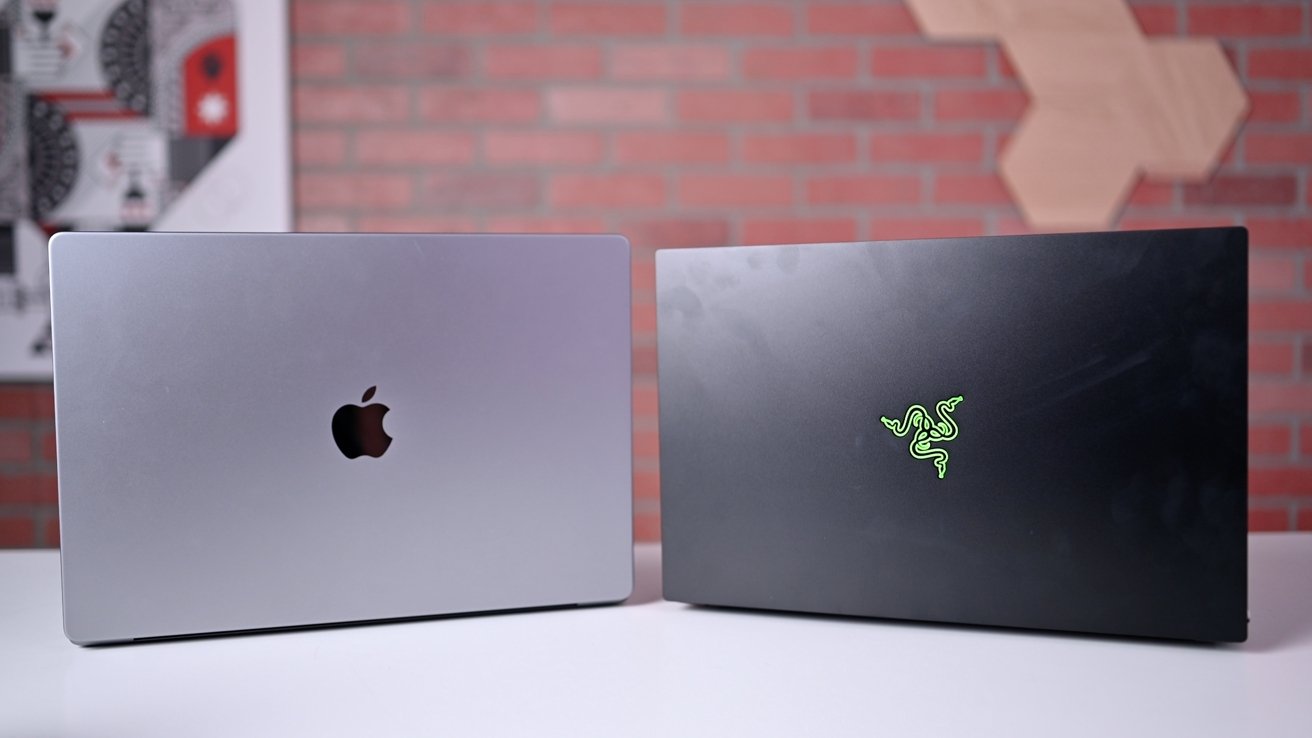
It's not quite the same story here. Razer has a notebook that's reasonably similar in terms of construction and size, with a marginally smaller screen. That display also happens to offer a higher pixel density and its OLED could be seen as a relatively comparable technology to the Mini LED display.
For a change, the features are fairly even with each other. Sure, they're not exactly the same, but they're close enough to be each other's equivalent.
You can still tease out some plus and minus points from each side though. For example, you're not going to be burning through electricity with the 16-inch MacBook Pro when under load versus the Blade, but you'll still get high performance from both notebooks.
To the Blade's benefit, it offers a touchscreen, an interaction that Apple has ignored, preferring to leave it to the iPad family. Then there are upgrades to memory and storage in the future, which simply aren't an option for the MacBook Pro.
The bottom line here is that, sure, Apple's comparison on performance to power savings is a worthy takeaway from looking at the two devices. But they're still great workhorses in their own right.
At press time, the best MacBook Pro deals offer triple-digit savings on both retail and configure-to-order (CTO) models at Apple Authorized Reseller Adorama with promo code APINSIDER and this activation link. Step-by-step instructions detailing how to redeem the coupon can be found here.
The Razer Blade 15 Advanced is currently on backorder at Razer directly and at B&H Photo.
Read on AppleInsider

16-inch MacBook Pro vs Razer Blade 15 Advanced
As part of Apple's promotion of its new M1-series MacBook Pro system-on-chip options, it made claims comparing the performance of the SoCs against existing on-the-market notebooks.
One comparison of the M1 Max with the 32-core GPU option claimed it offered "graphics performance comparable to that in a high-end compact PC pro laptop using up to 40% less power." A closer inspection of the press release has Apple saying that compact notebook was the Razer Blade 15 Advanced, complete with the model number, RZ09-0409CE53-R3U1.
At first glance, the configurations list of that particular notebook points to Apple selecting a very high-performance system, one that would be the epitome of a gaming notebook.
Using Apple's selected Razer Blade 15 Advanced configuration, here's how the rest of the notebook compares to the 16-inch MacBook Pro.
Specifications
| 16-inch MacBook Pro (2021) | Razer Blade 15 Advanced | |
|---|---|---|
| Display Size (inches) | 16.2 | 15.6-inch |
| Max Resolution | 3,456 x 2,234 | 3,840 x 2,160 |
| Pixel Density | 254 | 282 |
| Display Technology | Mini LED-Backlit, Wide Color (P3), True Tone ProMotion | OLED, 60Hz Touchscreen 100% DCI-P3 |
| Processors | 10-core M1 Pro, 10-core M1 Max | 11th-gen 8-core Intel Core i9-11900H |
| Memory | 16GB Unified Memory, up to 64GB | 32GB DDR4 3200Hz |
| Graphics | M1 Pro 16-core, M1 Max 24-core M1 Max 32-core | Nvidia GeForce RTX 3080 16GB, Intel UHD Graphics |
| Storage | 512GB, 1TB, 2TB, 4TB, 8TB | 1TB M.2 PCIe NVMe |
| Biometrics | Touch ID | Windows Hello |
| Trackpad | Force Touch | Yes |
| Keyboard | Backlit with ambient light sensor | Per-key backlighting with Razer Chroma |
| Dimensions (inches) | 14.01x 9.77 x 0.66 | 13.98 x 9.25 x 0.67 |
| Weight (pounds) | 4.7 (M1 Pro), 4.8 (M1 Max) | 4.4 |
| Battery Life | 21 Hours | Around 6 hours |
| Ports | 3 Thunderbolt 4 ports, HDMI, SDXC card slot, MagSafe 3, Headphone jack | 2 Thunderbolt 4 ports 2 USB-C 3.2 Gen 2 with 15W Power Delivery 3 USB-A 3.2 Gen 2 UHS-III SD Card Reader HDMI 2.1 Headphone jack |
| Webcam | 1080p FaceTime HD | 1080p IR |
| Speakers | Six speakers with force-cancelling woofers, Dolby Atmos | Stereo with THX Spatial Audio |
| Microphones | 3 with directional beamforming | 4-mic array |
| Wi-Fi | Wi-Fi 6 | Wi-Fi 6E |
| Bluetooth | 5.0 | 5.2 |
| Power Supply | 140W | 230W |
| Color Options | Silver, Space Gray | Anodized Black |
| Price | from $2,499 | $3,399 |
16-inch MacBook Pro vs Razer Blade 15 Advanced - Physical Dimensions
The MacBook Pro uses an aluminum shell in a pair of Apple's traditional Mac color options, namely Silver and Space Gray. It's a well-known and strong design that makes it instantly recognizable to onlookers.
Razer has tried to follow the same path with its own products, following Apple's playbook in providing a signature style and color scheme that it certainly employs in the Blade 15 Advanced. Razer certainly goes for a similar industrial appearance with flat sides and a thin body, though it uses a slight taper on the sides to enhance its slim appearance.
The body does copy Apple in being aluminum, except here Razer has anodized it black and made the company logo on the top a bright and contrasting green.
Apple has the larger design overall, but not by much, with a 14.01 by 9.77-inch footprint countered by Razer with 13.98 by 9.25 inches. The difference in footprint can be accounted for by Apple having a slightly larger display, but they're still quite comparable.
As for the thickness, the 16-inch MacBook Pro is 0.66 inches, while the Razer is 0.67 inches. This is quite commendable for Razer, given that most gaming notebooks tend to be much thicker overall.

Razer includes a smaller display, but one with a higher pixel density than the 16-inch MacBook Pro
On the weight side, Apple loses out a little bit here, in that the 16-inch MacBook Pro is either 4.7 pounds or 4.8 pounds, depending on whether you go for the M1 Pro or M1 Max. Meanwhile, the Blade is a bit lighter at 4.4 pounds.
16-inch MacBook Pro vs Razer Blade 15 Advanced - Display
This was touched upon earlier, but the two notebooks have quite different screens, in a large number of ways. The obvious one is the display size, with Razer opting for a 15.6-inch screen while Apple uses a 16.2-inch version.Apple's display has a resolution of 3,456 by 2,234 pixels, which gives it a pixel density of 254 pixels per inch. Razer's screen in this configuration is a 4K panel with a resolution of 3,840 by 2,160, and a higher pixel density at 282ppi.
There's a competing of technologies as well, with Apple choosing to use Mini LED for its backlighting, giving the MacBook Pro high levels of brightness at 1,000 nits fullscreen, 1,600 nits at peak. It also includes Wide Color (P3), True Tone, ProMotion support, and a 1,000,000:1 contrast ratio.
Razer's display in this particular notebook is an OLED panel, which can result in a brighter image with extremely high contrast ratios and color representation versus typical LED-backlit LCD screens. Razer has not specified what the contrast or brightness of the display are, but it's safe to expect the OLED panel to be bright and high quality in its own right.
The company does say the Blade's screen has 100% coverage of the DCI-P3 color space, HDR support, individual factory calibration, and a 1ms response time.

The OLED panel on the 4K Blade 15 Advanced is also a touchscreen.
The refresh rate for the Blade is just 60Hz, which is fairly standard, though while it falls short of Apple's display, it even fades behind alternate Blade configurations, such as a 360Hz 1080p screen, or a 240Hz QHD display.
The Blade does, however, benefit from being a touchscreen, an often clamored-for technology by some MacBook Pro users that has simply failed to make it onto the Mac.
Apple's screen is slightly hindered by the inclusion of a notch in the middle of the top edge, which cuts into the display. While it eats into the menu bar, macOS does push full-screen content to below the notch itself, effectively using the same space as a 16-inch display.
16-inch MacBook Pro vs Razer Blade 15 Advanced - CPU Performance
The new 16-inch MacBook Pro uses the M1 Pro and M1 Max, versions with 10-cores consisting of two efficiency cores and eight high-performance cores. The two versions are practically identical CPU-wise in their construction, but there are some other differences that can affect performance.For example, the Fabric in M1 Pro has a memory bandwidth of up to 200GB/s, whereas the M1 Max has double at 400GB/s. You can also have more memory on the Max, as the M1 Pro starts at 16GB with a 32GB option, while the M1 Max starts at 32GB with a 64GB upgrade available.
Another difference is the Media Engine, a new addition that handles video encoding and decoding tasks in an efficient way. Both can deal with H.264, HEVC, ProRes, and ProRes RAW encoding and decoding, but the M1 Max has two video encode engines and two ProRes encode and decode engines over the M1 Pro's version.
The Blade configuration used by Apple has the Intel Core i9-11900H, an 11th-generation Tiger Lake chip from Q2 2021. The eight-core, 16-thread chip has a base clock speed of 2.5Ghz, rising to 4.9GHz under Turbo Boost.
On a benchmark basis, the Core i9 scores around 1,600 for Geekbench 5's single-core test, rising to around 9,100 for the multi-core score.
In AppleInsider's running of the benchmark, the M1 Pro scored 1,760 and 7,723 respectively in the single and multi-core tests, while the M1 Max managed a comparable 1,769 and 12,308.
Obviously, Apple's new chips are running better, in part due to the higher per-core score, and that there are 10 cores to Intel's 8 cores.
16-inch MacBook Pro vs Razer Blade 15 Advanced - Graphics Performance
The main point of comparison for Apple is the Blade's graphics, and how the top-end M1 Pro pretty much matched the GPU Razer used.
This Apple-produced chart compared the 32-core GPU in the M1 Max with the Razer Blade 15 Advanced.
For that specific configuration, the Blade 15 Advanced was packed with an Nvidia GeForce RTX 3080 with 16GB of GDDR6. Razer also has configurations for an RTX 3060 and RTX 3070, but Apple went for the top end of the spectrum.
The processor also offers Intel UHD graphics as an integrated alternative to the discrete GPU.
The M1 Pro for the 16-inch MacBook Pro has an Apple-designed GPU with 16 cores, while the M1 Max increases the count to 24 cores or 32 cores.
Since Apple uses Unified Memory, the GPU shares the same pool of memory as the CPU, similar to integrated graphics options. It differs in that the Unified Memory structure allows the CPU, the GPU, and other elements to access the same memory collection without duplicating data into separate pools, making it potentially more efficient for processing.
This means that the GPU's memory relies on the amount configured with the Mac itself, so it has up to 64GB to play with in the higher-end configurations. To a point, this pretty much negates the Blade's advantage of having so much dedicated video memory.
AppleInsider's Geekbench 5 Metal benchmark tests saw a score of 40,991 for the M1 Pro with a 16 core GPU, while the M1 Max with a 32-core GPU achieved 68,950 in the same test. For reference, the M1 with an 8-core GPU scored 21,425 under the same test.
Here's where things get muddy, as it is not currently possible to perform the same Metal test using an Nvidia GPU due to a long-term lack of macOS support. The nearest analog would be the GeekBench OpenCL test.
As of yet, there are no posted OpenCL test results for the M1 Max or M1 Pro, however, there is one for the M1, at 18,260. Geekbench says the Geforce RTX 3080 as a laptop GPU scores 128,800.
Even if we go by Apple's claim of the M1 Max being four times as powerful as the M1, this still puts the theoretical M1 Max GPU's score at around 80,000, which still leaves quite a gap.
It remains unknown what exact combination of benchmark results Apple used to score a higher "relative performance" than that specific Blade's GPU, but it certainly doesn't take away the fact that Apple's made an integrated GPU that can perform very well.
At the same time, doing so without being as power-hungry.
16-inch MacBook Pro vs Razer Blade 15 Advanced - Camera and Biometrics
Apple includes a 1080p FaceTime HD camera in its 16-inch MacBook Pro, located inside the infamous display notch. While not benefiting from a full TrueDepth camera array, the imaging device Apple has used does at least benefit from the image signal processing elements of the M1.Razer uses its own 1080p webcam, though it is one with infrared capabilities, enabling it to support Windows Hello. This gives it a form of visual biometrics that Apple could've countered with Face ID, if it had included the aforementioned TrueDepth camera.
On the subject of biometrics, Apple does still offer Touch ID via a button in the top-right of the keyboard.
16-inch MacBook Pro vs Razer Blade 15 Advanced - Storage, Memory, Connectivity
Apple's storage options start from 512GB, rising to 1TB, 2TB, 4TB, and topping out at 8TB.The configuration of the Blade Apple selected uses a 1TB M.2 PCIe NVMe drive. Technically, you can have two such drives installed, so you can add a secondary drive for extra storage, or even replace the original drive.
There simply is no option to upgrade the storage of the 16-inch MacBook Pro, unless you use an external Thunderbolt drive or something similar.

Razer uses anodized aluminum for its Blade 15 Advanced casing.
On memory, Apple offers 16GB or 32GB of Unified Memory in the M1 Pro, rising to 32GB or 64GB in the M1 Max.
The Razer Blade 15 Advanced uses 32GB of DDR4 3,200MHz dual-channel memory, but again these are components that could be switched out for higher capacities at a later time. Once more, you cannot perform such switching with the MacBook Pro.
For connectivity, the 2021 MacBook Pro models improve from the previous generation by offering three Thunderbolt 4 ports along with HDMI, an SDXC card slot, a MagSafe 3 power connection, and a headphone jack.
Razer includes two Thunderbolt 4 ports, two USB-C 3.2 Gen 2 ports with 15W power delivery, 3 USB-A 3.2 Gen 2 ports, an UHS-III SD card reader, a HDMI 2.1 port, a power connection, and a headphone jack.
For wireless connectivity, the MacBook uses Wi-Fi 6 and Bluetooth 5.0, while the Blade opts for the newer Wi-Fi 6E and Bluetooth 5.2.
16-inch MacBook Pro vs Razer Blade 15 Advanced - Power and Other Details
In both cases, while you could charge the notebook by their respective dedicated power connections, you don't have to do that. Both could also be recharged using USB-C if required, enabling each to be used with a dock with built-in power delivery features.Apple includes a bigger battery in its MacBook Pro at 100W, versus the Blade's 80W unit. It also seemingly lasts longer in the MacBook Pro, with Apple claiming it offers up to 21 hours of video playback or up to 14 hours of wireless web access.
By contrast, reviews and benchmarks for the Razer put its battery life at around 6 hours on average. This isn't exact, as there's variations in testing methodologies at play, but given the generally low battery life of gaming notebooks, the figure is reasonably close to reality.
Razer includes a more powerful power supply with its Blade at 230W, while Apple uses a 140W version.
Apple includes more speakers in its MacBook Pro, with six including force-cancelling woofers and Dolby Atmos support to the Blade's Stereo with THX Spatial Audio support. Razer, however, has one more microphone at four in an array versus Apple's three with directional beamforming.

The keys are individually backlit on the Blade 15 Advanced, with full RGB capabilities.
The MacBook Pro keyboard includes a backlighting system for seeing the keys in the dark. With its gaming pedigree, Razer goes a few steps further.
The Blade 15 Advanced has a per-key RGB backlighting system, which can display over 16.8 million colors in various ways. It also offers dynamic lighting effects that work with over 150 Chroma-integrated games, so the keyboard lighting changes with your gameplay.
16-inch MacBook Pro vs Razer Blade 15 Advanced - Configuration Pricing
The specific configuration of the Razer Blade 15 Advanced, with the Core i9, GeForce RTX 3080, 32GB of memory, 1TB of storage, and 4K OLED touchscreen, costs $3,399. There are many other configurations available, and all but one are cheaper than what Apple selected, with the exception being a "Studio Edition" version fitted with a Quadro RTX500.The cheapest 16-inch MacBook Pro with the M1 Pro, 16GB of memory, and 512GB of storage costs $2,499. Bumping the RAM up to 32GB costs $400 extra.
Upgrading the storage from 512GB to 1TB costs $200, while it's $600 to move to 2TB, $1,200 to get 4TB, and $2,400 for 8TB.
The cheapest M1 Max with a 24-core GPU, 32GB of memory, and 512GB of storage retails for $3,099. It's $400 to go to 64GB of memory, with similar storage upgrade costs.
If you want the 32-core GPU in the M1 Max, it's an extra $200.
To get a matching-specification MacBook Pro to the Blade that Apple probably used in its testing, namely an M1 Max with a 32-core GPU, 32GB of memory, and 1TB of storage, that would cost you $3,499, about $100 more than the Blade in question.
A relatively even matchup
In other comparisons of high-performance notebooks that Apple itselfused, it was quite easy to say that the MacBook Pro provides a lot for the money. Along with fantastic performance, the rest of the MacBook Pro's features helped make it a formidable notebook to compete against its rivals.
It's not quite the same story here. Razer has a notebook that's reasonably similar in terms of construction and size, with a marginally smaller screen. That display also happens to offer a higher pixel density and its OLED could be seen as a relatively comparable technology to the Mini LED display.
For a change, the features are fairly even with each other. Sure, they're not exactly the same, but they're close enough to be each other's equivalent.
You can still tease out some plus and minus points from each side though. For example, you're not going to be burning through electricity with the 16-inch MacBook Pro when under load versus the Blade, but you'll still get high performance from both notebooks.
To the Blade's benefit, it offers a touchscreen, an interaction that Apple has ignored, preferring to leave it to the iPad family. Then there are upgrades to memory and storage in the future, which simply aren't an option for the MacBook Pro.
The bottom line here is that, sure, Apple's comparison on performance to power savings is a worthy takeaway from looking at the two devices. But they're still great workhorses in their own right.
Where to buy
Apple's 2021 16-inch MacBook Pro is already discounted, with exclusive coupon savings at your fingertips in the AppleInsider 2021 16-inch MacBook Pro Price Guide.At press time, the best MacBook Pro deals offer triple-digit savings on both retail and configure-to-order (CTO) models at Apple Authorized Reseller Adorama with promo code APINSIDER and this activation link. Step-by-step instructions detailing how to redeem the coupon can be found here.
The Razer Blade 15 Advanced is currently on backorder at Razer directly and at B&H Photo.
Read on AppleInsider


Comments
The PC in the video has a 3080 at a lower power like the Blade and as soon as it starts running, it's getting too hot and having to cool down and the overall performance ends up lower than the M1 Max, while making way more fan noise. It's even lower performance than a 3060 in that test.
Apple picked the right performance profile by being able to maintain good performance without getting too hot, keeping the fan noise low and performance stable. PC companies are playing games with their spec sheets trying to push buyers onto higher GPUs and not disclosing that two laptops with the same GPU can vary in performance by 50-100%:
https://www.notebookcheck.net/Here-are-all-the-slowest-and-fastest-GeForce-RTX-3080-laptops-you-can-buy-right-now.529039.0.html
Shadow of the Tomb Raider is a pretty good test because it's one of the few games tuned well on the Mac with Metal support.
It would be hard to get consistent testing between power draw and performance due to the GPUs all dynamically change their power depending on temperature. Apple probably measured a peak power difference during some tests. The video is pretty clear though that in a thin and light laptop, a 3080 isn't able to maintain a high performance level. It will maintain a higher performance level in a heavier, bulkier gaming laptop but with more power draw and fan noise. It's just lucky for Nvidia/AMD and PC laptop manufacturers that they have some software advantages for games and compute because that difference in performance and fan noise looks embarrassing.
The serious PC hardware testers usually compare GPUs with a battery of tests, both synthetic benchmarks (like 3DMark Time Spy and 3DMark Port Royal) and actual games -- recent titles with demanding graphics. There could be 4-6 synthetic benchmarks and a suite of actual games, between 8 to 15 games.
Geekbench is the synthetic benchmark that is most frequently quotes by Mac followers but it is deeply flawed. One glaring problem is that the runtime is too short to subject hardware to an extended workload. Serious PC hardware reviewers frequently ignore Geekbench. 3DMark is a better synthetic graphics benchmark but it runs on Windows, iOS and Android, no macOS.
For real world game testing, the biggest problem is the lack of recent AAA titles for macOS. There should be a variety of games but all of them should be relatively demanding from a graphics perspective. No one benchmarks GPUs with Disco Elysium or with an old game that will run on a potato even if it is an enjoyable classic like Left 4 Dead 2 (which is like twelve years old).
The only two really graphically demanding macOS games from recent years are Shadow of the Tomb Raider and Metro Exodus both of which run under Rosetta 2 on Apple Silicon Macs. Some might argue that testing Macs with games running under Rosetta 2 is unfair but others would point out that it IS real world performance.
Games like Cyberpunk 2077, Resident Evil Village, various driving or flight simulations (like Dirt, F1 or Forza Horizon), Far Cry 5, Borderlands 3, Red Dead Redemption 2, or Horizon Zero Dawn don't exist for Mac. All of those -- in addition to Shadow and Metro -- are titles frequently used by PC reviewers.
Testing 3D productivity software would also be problematic. You can't run Final Cut Pro on Windows PCs so you'd have to rely on applications that are multi-platform. Adobe? DaVinci Resolve? Blender?
My guess is AI doesn't actually have the hardware in hand to test, so all they can do is a spec sheet comparison, which is pretty uninteresting.
Spec sheet comparisons are useless. But Mac news readers are accustomed to that.
Comparing unoptimized Apple Silicon synthetic benchmarks to Windows PC optimized synthetic benchmarks is arguably justifiable because that comparison will most closely represent CURRENT real world performance.
If most synthetic benchmarks aren't optimized for Apple Silicon and most real world applications aren't either, well, it's no so far fetched.
Most people do things with their computers other than run benchmarks.
There were just to many emotive, irrational, old-thinkers with loud voices who lashed out when something was taken away.
These ports make as much sense as the Mac Pro.
And you didn’t even address my point. If Apple were trying to appease the “old-thinkers”, then it seems even more odd that they’ve left room for criticism by delivering outdated protocols.
M1 Pro = Laptop i9+RTX3080
This looks to be about the same as the Razer;
https://forum.affinity.serif.com/index.php?/topic/124022-benchmark-1900-results/&do=findComment&comment=849573
And this is the M1 Pro MBP;
https://forum.affinity.serif.com/index.php?/topic/124022-benchmark-1900-results/&do=findComment&comment=850152
M1 Max = Desktop i9/5950X+RTX3090;
https://www.pugetsystems.com/benchmarks/?age=30&benchmark=&application=premiere&specs=5950X#results-table
https://www.pugetsystems.com/benchmarks/?age=30&benchmark=&application=premiere&specs=m1+max#results-table
It's been about five years since I had a work laptop (MBP) and I almost always used it at a desk anyway.
I don't think Apple consider these ports to be nonsense. It also doesn't strike me as very Apple-like to consciously do a half-assed job.
HDMI is probably restricted by the M1's limited I/O, but the SD speed and Bluetooth versions are an odd limitation.
if it beats the rest, good. If not, let’s say that they suppose to be a lower-tier chip that competes with a higher class.
We all knew the Mac Pro was a piss-take product when they charged $400 for the wheels. The whole product screams of "If you want old-school PC architecture overkill, here's old-school PC architecture overkill but you're gonna pay for it". They knew it was "faster horses" because they were creating a NoteBook which chews out most of the Mac Pro range's workloads (up to 8K video editing). I wonder how many 24+ core Mac Pros they actually sold, I'm thinking not many.
Postulating that Apple deliberately didn't do something that was easy for them to do in order to spite customers who don't know what they want (while giving them want they want) seems bizarre to me. Apple are in the business of selling things; they want to make things that people will buy. The MBP seems like it doesn't have HDMI 2.1 because it can't, the M1 doesn't support it. And it has slower SD and Bluetooth speeds probably just because Apple had other priorities. I'm sure they'll fix it, though it's a little disappointing that they need to.
As for the rest, I'm not interested in HDMI vs DisplayPort penis waving. They're both good interfaces, with capability well beyond what most people will use them for anyway, and are appropriate in different situations. Apple know this, and I see no evidence for the "downplaying a substandard tech" that you're talking about. They included it because people want it, and Apple have an interest in giving people what they want. Simple as.
And quit with the "insulted their customers’ intelligence" crap. Lots of people are happy to see these ports back, and they aren't unintelligent for it. You've got a severe case of the superiority syndrome, just because you don't need or want HDMI.
As for TB4 not encapsulating HDMI2.1 it’s not a lack of performance, as DP2.0 drives at a higher bandwidth, it’s just not supported by the standard and so the M1 Thunderbolt controllers won’t deliver it. That would require extra dedicated controllers & transistor budget.
HDMI’s only real advantage is CEC a consumer device control standard, apart from that it’s an inferior standard so why would Apple go all out to support it with extra controllers?